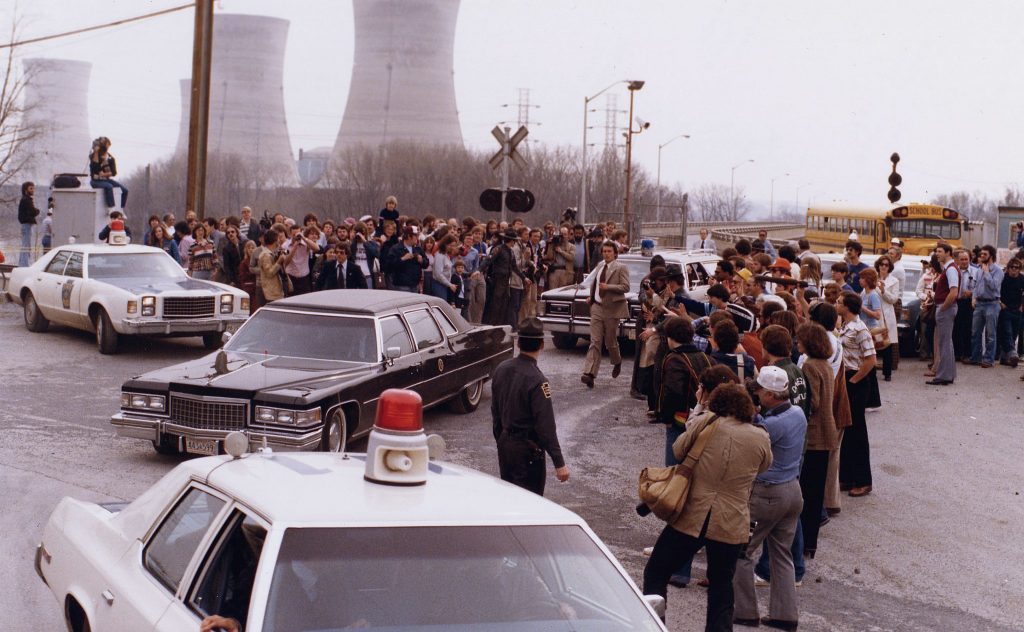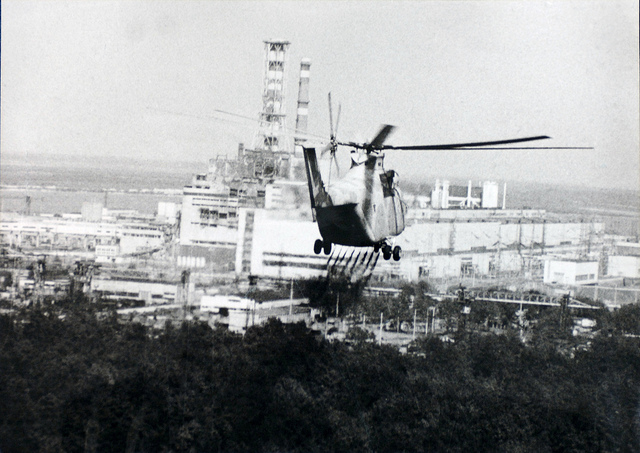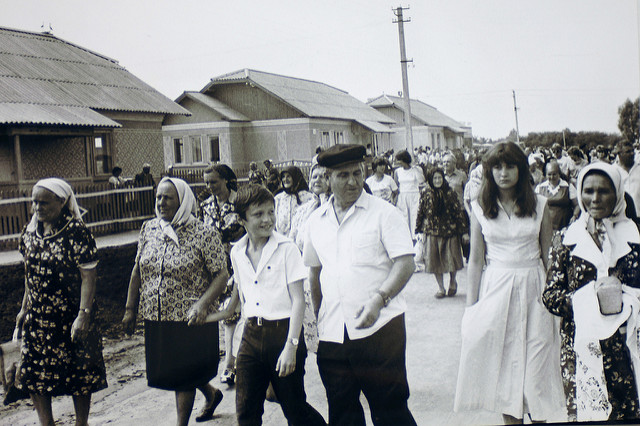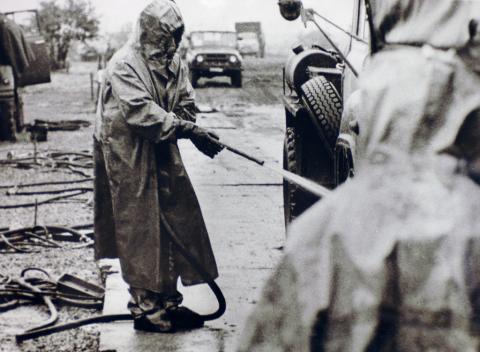Following World War II, countries around the world began to develop nuclear reactors to meet civilian energy needs. In the core of the nuclear reactor, the heat from fission or splitting of uranium atoms is used to produce steam. This steam is used to power a turbine to generate electricity.
While nuclear reactions produce huge amounts of energy and emit few greenhouse gases, nuclear power has been a source of controversy among governments, experts and the public. One of the main reasons people are fearful of nuclear power is the possibility of accidents. This fear is generally fueled by three high-profile nuclear accidents: Three Mile Island, Chernobyl, and Fukushima Daiichi.
Each of these accidents involved a partial or full core meltdown. A core meltdown is when the reactor’s core severely overheats and cannot be sufficiently cooled down. However, when the core of the reactor melts down it stops the reaction; there is no possibility of an atomic explosion. If the reactor core is fully contained, the major concern is whether there is any release of contaminated air or liquids into the environment.
Three Mile Island
On March 28, 1979, one of the two reactors at the Three Mile Island (TMI) plant in Middletown, Pennsylvania experienced a partial meltdown. Half of the TMI-2 reactor’s core melted down, resulting in the release of a small amount of radioactive gases and iodine into the environment. The Three Mile Island accident alarmed the surrounding communities. However, studies have found no evidence of adverse health and environmental consequences. Higher radiation levels were detected in the basements of homes in the vicinity where there were high levels of naturally occurring radon in the ground.

The accident resulted from a combination of design deficiencies and component breakdowns. A mechanical or electrical failure prevented water from going to the steam generators. Without water, the steam generators could not remove heat from the reactor’s core. This eventually led to a buildup in pressure within the reactor and caused the operators to open the pilot relief valve to relieve pressure. This valve got stuck and resulted in a continued loss of coolant. In the absence of coolant, the reactor overheated and caused half of the reactor core to melt.
These issues were further compounded by personnel error. At one point, the staff incorrectly assumed a reading of high water levels in the pressurizer meant the core was properly covered with water. In reality, the plant was losing coolant.
While the accident caused severe damage to the reactor, it did not lead to extensive complications outside the plant because the reactor’s containment unit remained functional. This was not the case for the accidents in Chernobyl and Fukushima.
Approximately two million people living around TMI-2 were estimated to have received an average radiation dose of about one millirem above the usual background dose. A millirem is a unit of absorbed radiation dose by the human body. To put this in perspective, a chest X-ray has a dose of about six millirem and the average yearly exposure in the area was about 100-125 millirem.

In his interview on the Voices of the Manhattan Project website, engineer William Lowe described working in the control room during the TMI accident. Remembering the urgency and chaos during the accident, Lowe recalled how George Kudrow, the technical support director, had been up for “38 hours trying to figure out what was happening at the plant.” Kudrow gave Lowe a “verbal data dump, just continuous talking. He could not stop talking.”
Listening to Kudrow’s explanations, Lowe realized they needed to stabilize, not restart, the TMI-2 reactor. Lowe considered calling Joe Henry, the head of the Nuclear Regulatory Commission (NRC), for help, but ultimately did not because he knew “Jimmy Carter was all over Joe to get some answers” and wanted to avoid government intervention.
Witnessing the situation in the control room, Lowe came to the conclusion that the reactor was full of hydrogen and the core had sustained severe damage. Chemical reactions in the reactor’s melting fuel created this build-up of hydrogen and hydrogen gas bubble. He helped perform calculations to assess the amount of damage to the core and the size of the hydrogen gas bubble. His work helped the TMI operators stabilize the reactor and reduce the size of the hydrogen bubble.
Although initial newspaper reports of the TMI accident raised concerns about the release of radioactive iodine, the accident did not cause any deaths or adverse effects to humans, animals or plants in the surrounding area. This conclusion was based on evidence from numerous epidemiological studies. In response to the accident, the NRC broadened and strengthened its regulations and oversight of nuclear power plants. After stabilization and clean-up, the TMI-2 reactor was permanently shut down.
Chernobyl
On April 26, 1986, the Soviet Union’s Chernobyl plant near Pripyat, Ukraine experienced the worst nuclear power plant disaster in history. The plant’s reactor in Unit 4 experienced a surge of power and a full reactor meltdown.
Along with the meltdown, there was a steam explosion, which caused the reactor’s roof to collapse and released radioactive substances and fission products into the atmosphere. These particles would spread to parts of Belarus, Russia and Ukraine.
The Chernobyl accident was a result of design flaws with its reactors and human error. The Soviet Reactor BolshoMoschchnosty Kanalny (RBMK) design was used to produce plutonium and electrical power. The RBMK reactor employed a combination of a graphite moderator and water coolant. This design differs from the Boiling Water Reactors (BWRs) and Pressurized Water Reactors (PWRs) used in the United States. BWRs and PWRs do not use graphite as a moderator; instead, these reactors use water as both a coolant and a moderator.

These design factors along with the reactor’s high instability at lower power due to its control rod design and “positive void coefficient” led to the accident. A positive void coefficient means that as power increases or water decreases, there is an increase in steam production and temperature of the fuel. At a lower power level, however, the reactor could become overheated, unstable and prone to power surges because of the positive void coefficient effect.
The Chernobyl plant also lacked an emergency preparedness plan in case of a radiation emergency. Unlike American nuclear reactors, the Chernobyl reactors did not have any protective containment structures. During the Three Mile Island accident, the protective containment structures over the reactor helped prevent damage outside of the plant.
To contain the Unit 4 reactor, a large concrete “sarcophagus” was built and placed over the reactor in December 1986. This structure was replaced on November 29, 2016 with the New Safe Confinement, an arch-shaped cover made of steel and concrete. The new cover is expected to last for the next 100 years.
As a result of the accident, the Soviet government ordered an evacuation for anyone within eighteen miles of the reactor. The town of Pripyat is now uninhabited and remains a part of the Chernobyl Exclusion Zone. A total of 115,000 people were evacuated in 1986. That number increased in later years to 220,000 people as the exclusion zone and information about contaminated areas were finalized.

Unlike at Three Mile Island, there were directly-linked deaths to the accident: firemen and first responders who died of acute radiation sickness. According to the World Health Organization (WHO), as of 2006, investigations show twenty-eight people died in 1986 due to acute radiation sickness (ARS) and nineteen people died between 1987-2004 from non-ARS causes. The general population in the contaminated areas did not have any ARS cases because they were exposed to much lower doses of radiation.
According to the United Nations Scientific Committee on the Effects of Atomic Radiation’s (UNSCEAR) 2008 Report: Volume II, recovery operation workers received an average effective dose of 117 mSv (millisieverts) during the period of 1986-2005. A millisievert is a measure of the absorption of radiation by the human body. In this same period, evacuees received an average of 31 mSv and inhabitants of contaminated areas of Belarus, Russia and Ukraine received 9 mSv on average.
Although the report noted approximately 150,000 people from the contaminated areas received a dose of more than 50 mSv over this period, it also said that about seventy percent of the population experienced effective doses below one mSv. About twenty percent received between one and two mSv. For comparison, the annual average effective dose from natural background radiation is 2.4 mSv (equivalent to 48 mSv in twenty years) and the typical effective dose from a CT scan is about 10 mSv.
Evidence collected by the WHO does not generally show connections between the accident and radiation-induced increases of leukemia or cancer within the general population in the surrounding areas. The exception is thyroid cancer. Many youth in the most affected areas developed thyroid cancers from drinking milk with radioactive iodine in 1986. Through 2005, there had been 6,000 recorded cases of childhood thyroid cancer cases, but 99 percent of them have been successfully treated. From 1986 to 2005, there were fifteen recorded deaths from associated childhood thyroid cancer.
According to the WHO’s “Chernobyl at 30” update in 2016, national studies in Belarus, Russia and Ukraine have recorded more than 11,000 thyroid cancer cases. The 2006 WHO report anticipated a rise in thyroid cancer incidence from Chernobyl over time. The 2016 update reported, “It is most likely that a fraction of these thyroid cancers is attributable to radioiodine intake in 1986.” The rise in thyroid cancer cases in these populations can also be attributed to aging and an increase in spontaneous thyroid cancer risk.
Fukushima
The most recent of the three accidents, the Fukushima Daiichi plant accident, occurred on March 11, 2011 in Fukushima, Japan, after an enormous 9.0 earthquake off the coast of Japan and subsequent tsunami.
Following the earthquake, the Fukushima Daiichi plant lost all power. The steam and battery-powered generators for the reactors of Units 1, 2, and 3 worked for several hours, but eventually, they failed. The tsunami damaged the facility’s reactor cooling, water heat exchangers, generators, electrical switchgear and batteries, which left the plant without emergency electrical power. As a result, all three reactors overheated and they each had at least partial core meltdowns. ![Fukushima Accident Diagram - Units 1-4 and trenches (#5) labeled. Diagram by Sodacan. This vector image was created with Inkscape. [CC BY 3.0 (http://creativecommons.org/licenses/by/3.0)], via Wikimedia Commons](https://ahf.nuclearmuseum.org/wp-content/uploads/2017/07/Fukushima Nuclear Accident diagram.png)
Increased pressure in the reactors also led to some leaks of radioactive gas and hydrogen. Hydrogen buildup led Units 1 through 4 to explode. The explosions caused increased building damage and release of radioactive material from Units 1 and 2.
Beside Fukushima Daiichi, two other nuclear power plants were in the affected area of the earthquake and tsunami. Through quick thinking and heroic actions by plant operators, Fukushima Daini avoided meltdowns like those experienced at its sister site Fukushima Daiichi and completely shut down all four of its operating reactors. Onagawa Nuclear Power Station fared the best out of all three plants, despite being the closest to the epicenter of the earthquake.
According to the Bulletin of Atomic Scientists, the differences in damage to the Fukushima and Onagawa plants can be boiled down to poor architectural planning and lack of emergency planning at Fukushima. While the Tohoku Electric Power Company took precautions against tsunamis by building its Onagawa plant at five times the height of an average tsunami, the Tokyo Electric Power Company (Tepco) did the opposite at Fukushima Daiichi. In 1967, Tepco removed twenty-five meters from the Daiichi plant’s thirty-five-meter natural seawall and built the plants’ reactor buildings almost five meters lower than those at Onagawa.
In terms of emergency procedures, Tohoku Electric responded to the earthquake in an organized, collaborative and controlled manner. The company created an emergency response center at the Onagawa plant and company headquarters, which worked together throughout the disaster to assess and solve reactor problems. Tepco, on the other hand, lacked a strong safety culture and failed to have an adequate emergency preparedness plan.
.jpg)
On March 12, 2011, the Japanese government ordered a compulsory evacuation for people living within twenty kilometers of Fukushima Daiichi and recommended sheltering and a voluntary evacuation for those twenty to thirty kilometers from the plant. Approximately 100,000 people were evacuated from the area.
According to the UNSCEAR, people near the accident were exposed to relatively low doses of radiation. The June 2017 Fukushima Healthy Management Survey provides a percentage breakdown of radiation dose estimates from areas within the Fukushima Prefecture. The survey’s results showed that a majority of civilian respondents from Kempoku and Kenchu had an estimated external radiation dose of less than two mSv, whereas most respondents from Kennan, Aizu, Miniami-aizu, Soso and Iwaki had a dose of less than one mSv. To put this in context, previous epidemiological studies have found no evidence of severe health effects at radiation doses less than or equal to 100 mSv. The accident also did not cause any acute radiation injuries or deaths among workers or the public.
A 2015 WHO study found that people who believed they would face immediate, delayed or genetic radiation risks had an increased amount of psychological stress following the Fukushima accident. In terms of environmental effects, there has not been evidence of marine animal deaths directly linked to the accident.
Beginning in September 2015, the Japanese government began to reopen towns and residential areas within the twenty-kilometer exclusion zone. The first town to be reopened was Naraha, which previously had a population of 7,400 residents. Most of the areas in the immediate vicinity of the accident remain off limits.
Legacies of the Accidents
Although a 2007 Lancet study concluded nuclear power, compared to other sources of energy like coal, has one of the lowest levels of greenhouse-gas emissions and smallest levels of direct health effects, nuclear energy remains controversial because of its ties to these high-profile accidents and historic origins with the atomic bomb.
![Anti-Nuclear Power Rally in Harrisburg, PA in 1979. Photo by unknown, National Archives and Records Administration (NARA) [Public domain], via Wikimedia Commons](https://ahf.nuclearmuseum.org/wp-content/uploads/2017/07/Anti-nuke_rally_in_Harrisburg_USA-200x300.jpg) Last year, the majority of the American public opposed nuclear energy for the first time in history. According to the 2016 results of the annual Gallup poll on nuclear energy, 54 percent of Americans said they oppose nuclear energy.
Last year, the majority of the American public opposed nuclear energy for the first time in history. According to the 2016 results of the annual Gallup poll on nuclear energy, 54 percent of Americans said they oppose nuclear energy.
Gallup noted the 11 percent increase in Americans opposed to nuclear energy (2015: 43% vs. 2016: 54%) is probably due to lower gas prices rather than increased concerns about nuclear power. However, the relative ten-year stability of the percentage of Americans opposed to nuclear power, around 40 percent, is still noteworthy.
Despite the continued debate around nuclear power, there sixty civil nuclear power nuclear reactors under construction around the globe. Currently, there are 448 operable civil nuclear power nuclear reactors around the world. Beside reactors for civilian electrical needs, there are hundreds of other nuclear reactors used for university and laboratory research worldwide. Compared to all other countries, the United States has the most operable reactors at ninety-nine. France, however, relies on nuclear energy the most for electricity production, with 72.3 percent of its total electricity coming from nuclear energy.
Using global data from all previous core melt accidents and an estimated failure rate of 1 per 3704 reactor years, a 2016 Bulletin of the Atomic Scientists study predicted that more than one core melt accident could occur globally within the next decade. Their analysis also showed little to no evidence of plant operators and workers learning from errors and mistakes made during past accidents.
In his interview on the Voices of the Manhattan Project website, physicist and high school science teacher Jay Shelton said most studies about nuclear accidents have shown that the greatest health risk is actually from non-radiological reasons such as evacuation. Shelton noted that “the fear of radiation causes evacuations, and the evacuations can be panicky and cause enormous psychological stress.” According to Shelton, the psychological stress can cause people to be afraid to eat due to fears of radiation poisoning, as well as lead to an increase in suicide rates.

Nuclear power continues to generate fierce debate in the United States and around the world. Nuclear power has advantages such as low greenhouse gas emissions and relatively inexpensive long-term costs. The case against nuclear power, however, remains resilient due to public fear of radiation and concern fueled by the memory of accidents like Three Mile Island, Chernobyl, and Fukushima Daiichi. However, fear of radiation and public misinformation can sometimes have even worse health consequences. In determining future energy decisions and policy, it is important to carefully consider the benefits and risks of nuclear power.





